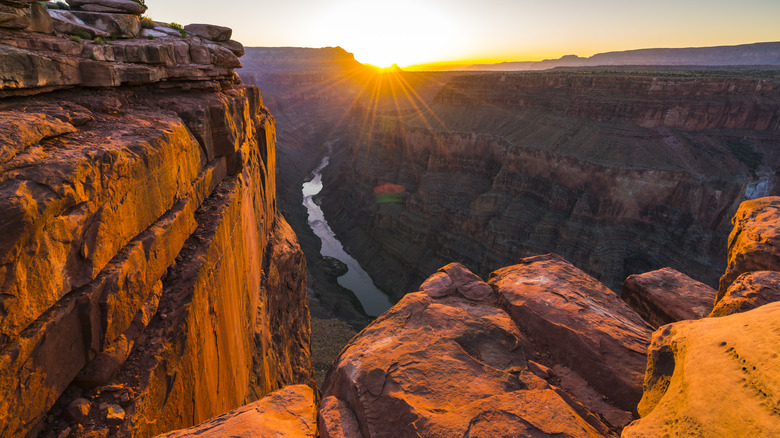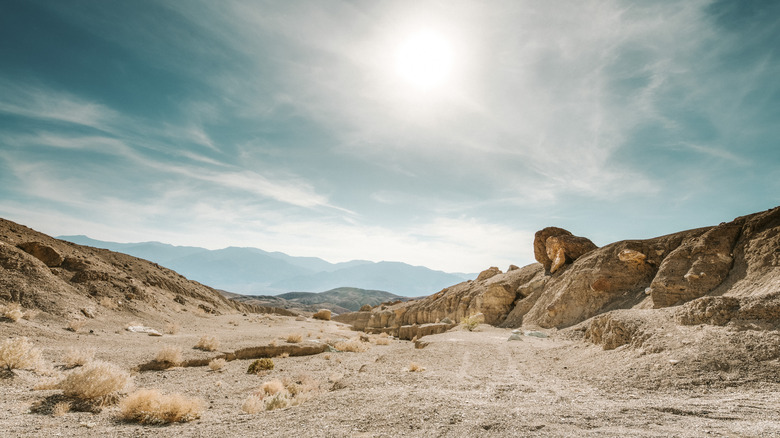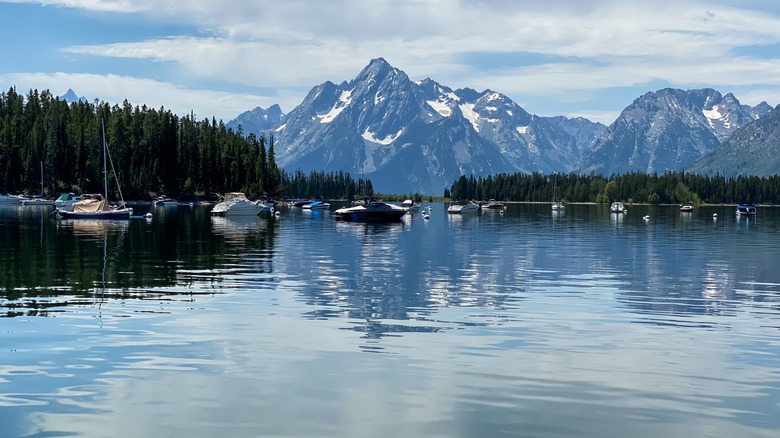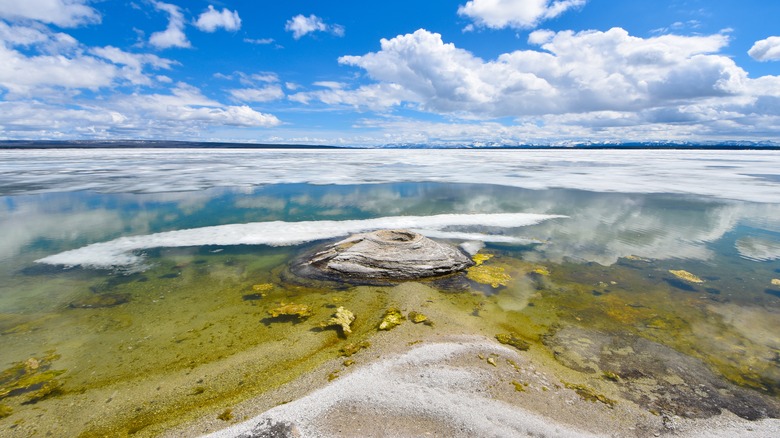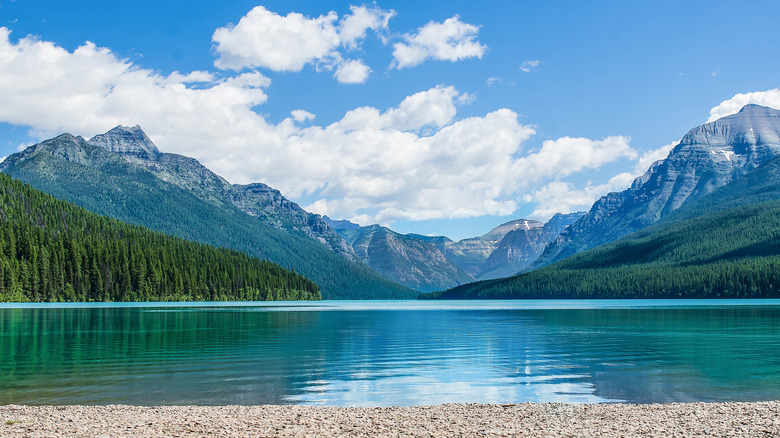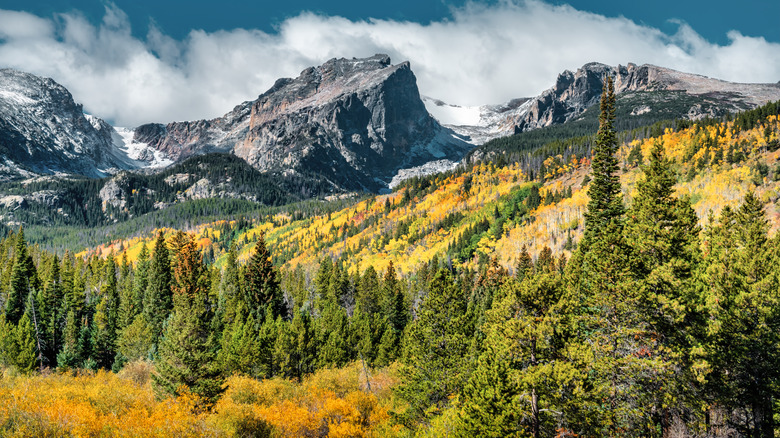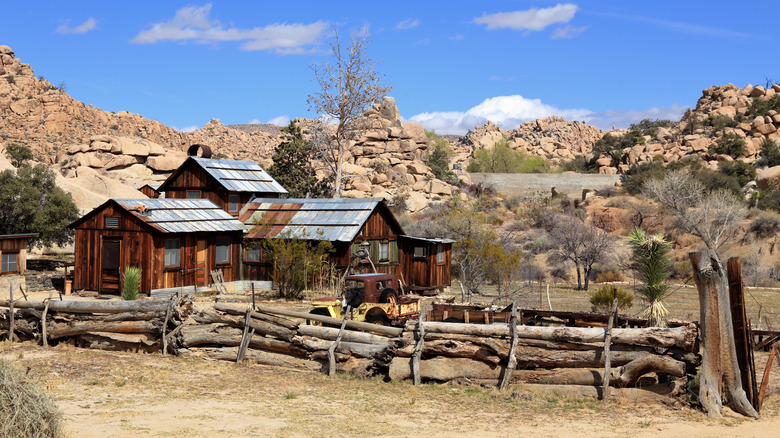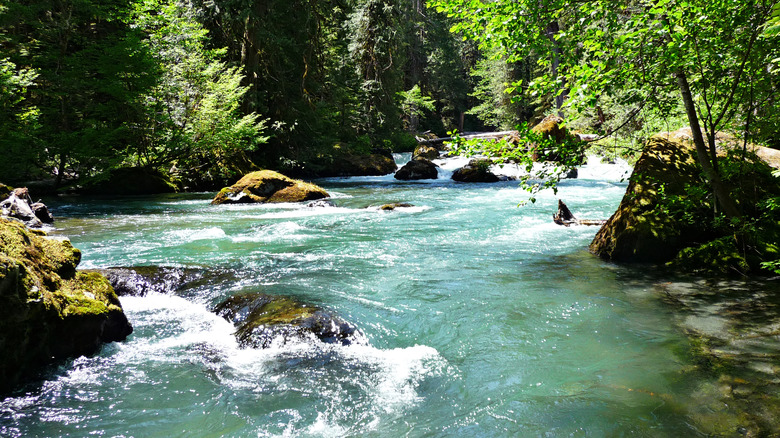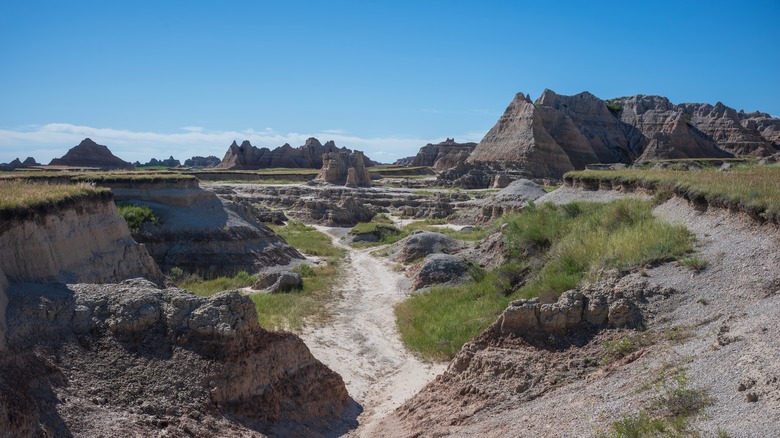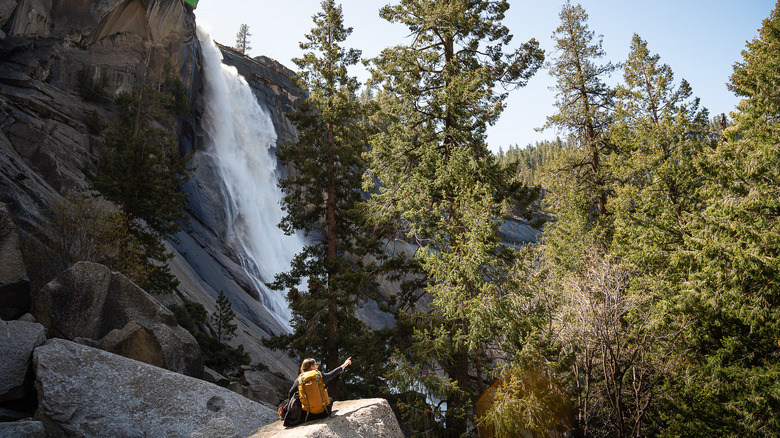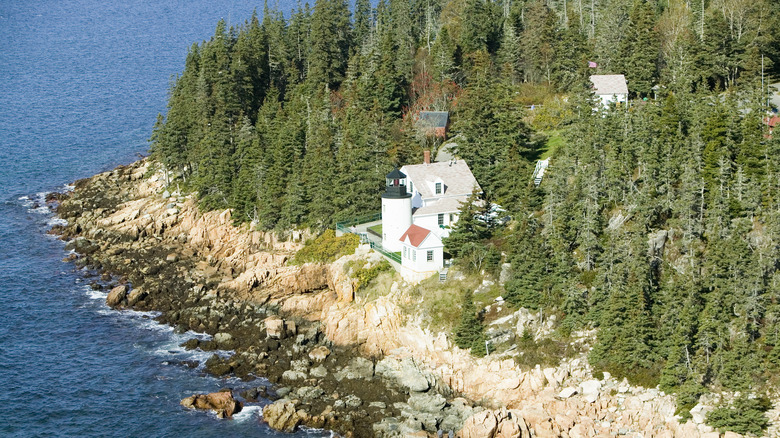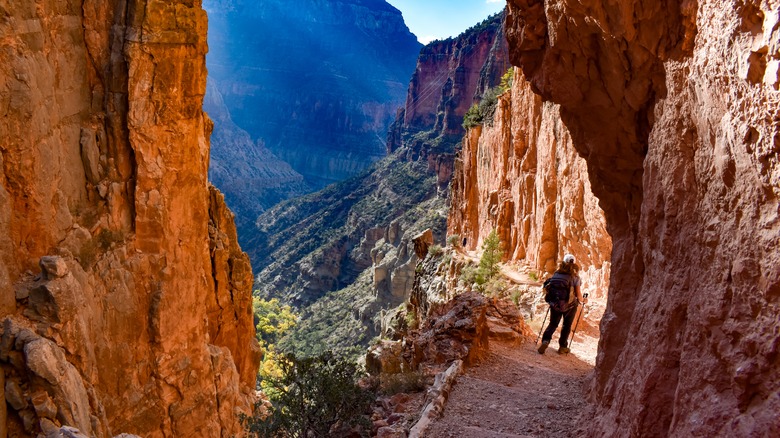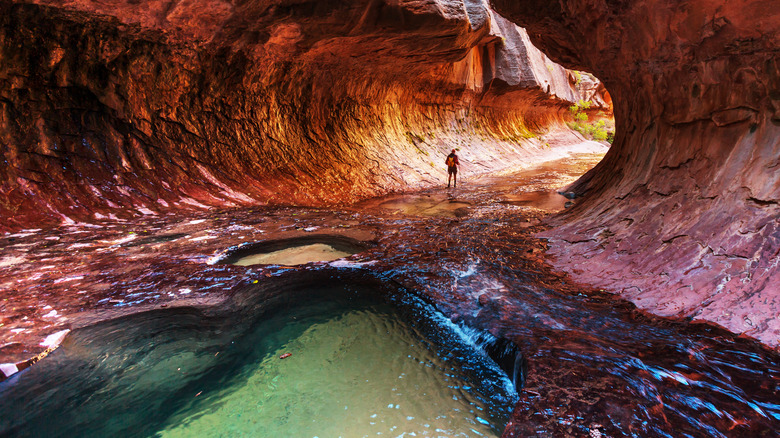Lesser-Known Destinations Within Popular National Parks For An Escape From The Crowds
If Americans want to go on a trip without the hefty price tag of spots like European cities, tropical islands, and exotic destinations, they don't have to go too far — they can just go to one of the 400-plus national parks dotted around the country, which offer natural respites that allow them to see the beauty of nature. Of course, these adventurers wouldn't be the first to have that bright idea. In 2023, 325 million people visited U.S. national parks, a 4% increase on the previous year, showing that people are only getting more interested in seeing American wildlife and landscapes.
However, that means those landscapes are getting much more disturbed. Today, sights like Old Faithful in Yellowstone National Park, Horsetail Falls Firefall in Yosemite National Park, and the Delicate Arch in Arches National Park are wildly popular, which means major crowds can follow, doing anything but allowing you to enjoy the serenity of nature. Their popularity can lead to long waits on trails, full parking lots, or even a lack of available entrance tickets. But that doesn't mean you need to forego your trip to a national park — there are plenty of hidden gems within U.S. national parks that are less crowded than their better-known counterparts. Here's where to go if you're looking to enjoy the stunning sights of our natural world without big crowds or waiting in line, waiting for a parking spot, or waiting for a ticket. Less waiting, more wonder.
Grotto Canyon, Death Valley National Park
Casual climbers and families with kids usually head to Mosaic Canyon, a popular spot for Death Valley National Park visitors to explore. However, just a few miles away is Grotto Canyon, which continues to enjoy relative anonymity — helped by the fact that the park map doesn't display it and it's only accessible by an unmarked dirt road that should only be traveled via a 4x4 vehicle. Those looking for a trip to Death Valley National Park without the crowds — and more of a challenge — should head to this little-known hotspot. It will take about two to four hours to hike the 2 to 4 miles, depending on the level of your climbing skills.
Don't take those climbing skills for granted. This is a challenging hike, and some people bring ropes and harnesses to help them traverse some of the more difficult climbs, including a high dryfall, a slim, smooth, 8-foot chimney, a 15-foot climb, and another tall peak that, thankfully, includes a few smaller rocks to help struggling climbers. It's worth it to those who love a good climb, especially when turning back and hopping down the climbs they once struggled to ascend. Climbing notwithstanding, seeing it by car is best, so take a one-way drive through this colorful national park. Who knew death could be so colorful?
Colter Bay, Grand Teton National Park
If you visit Colter Bay in Grand Teton National Park, you'll be able to enjoy relative solitude, partly because a stay here involves serious planning. Advanced reservations for campsite stays are required and can be booked up to six months in advance. It's worth it to have access to the bay, which has seemingly endless opportunities for fun on the shores of Jackson Lake. One of the best activities here is to go on a scenic hike, with everything from easy to difficult trails available for amblers. The options include the Lakeshore Trail (an easy hike with great views that takes about one to two hours), the Heron Pond-Swan Lake Loop Trail (another serene hike passing bodies of water and tons of wildlife that takes about one to three hours), and Hermitage Point, a more difficult trail that takes four to seven hours but offers which amazing views of the lake as well as views of the Teton Range.
You can also boat the lake with your own boat, although you'll need to get a permit or rent a vessel from the marina. It costs anywhere from $30 to $300 to rent a boat (options range from a kayak to a motor boat) from the Grand Teton Lodge Company. No matter what you do, you'll have unmatched access to the beautiful wildlife here, such as bears, moose, elk, fish, and birds.
West Thumb Geyser Basin of Yellowstone Lake, Yellowstone National Park
The West Thumb Geyser Basin of Yellowstone Lake in Yellowstone National Park was formed around 150,000 years ago due to a volcanic explosion, creating a hole that eventually filled with rainfall. Much, much later, the area became a popular spot for tourists with campsites, cabins, cafeterias, and a gas station, but the buildings were removed in the 1980s so visitors could appreciate the basin's natural beauty. Since then, it's become the place to go for tourists wanting to enjoy the thermal masterpieces of Yellowstone National Park without the crowds that crowd popular park spots like the Mud Volcano, Upper Geyser Basin, and Fountain Paint Pots. However, the West Thumb Geyser Basin lacks larger geysers, and the waves of the lake can hide other thermal features.
If you're looking for undisturbed natural beauty, this is the spot, as the West Thumb Geyser Basin is one of the most rarely-visited basins in the area. Once here, follow the right path at the fork in the road to check out unique pools like the Collapsing Pool and ever-blue Blue Funnel Spring. Back near the lakeshore, visit the amazing teal-colored Abyss Pool and deep-blue Black Pool. Then, check out the Fishing Cone, also known as the Hot Spring Cone, which was formerly used for boiling fish caught in Yellowstone Lake. Since the practice can be dangerous and unhealthy, it's no longer allowed.
Kintla and Bowman Lakes, Glacier National Park
Hardy hikers love giving the trail between Kintla and Bowman Lakes in the northwestern part of Glacier National Park a go. With 39 miles of trails between the two lakes, it's a challenging yet scenic hike with much to see, including stunning views, wildlife, Boulder Pass and Brown Pass, and the Hole In The Wall glacier cirque. Partly due to its difficulty, fewer hikers can be found on this route, and since both the Bowman Lake Campground and Kintla Lake Campground are secluded, it doesn't matter which direction you decide to start the trail at — you'll still find yourself mostly undisturbed.
No trailers are allowed on the road to Bowman Lake Campground, and the route is also a rough one due to its bumpy, dirt terrain. Plus, heavy foliage shields some sections of the campground, so you'll feel like you're on your own here. Much of the same can be said for the Kintla Lake Campground, which is the most remote campground in the park — a whopping 40 miles from the nearest entrance. The road to get here is also bumpy and doesn't allow trailers. Once you arrive, there's a good chance you won't see another soul since it's seldom booked up. Both lakes and campgrounds are part of the park's North Fork, where you're likely not to have any cell phone service and driving a 4x4 vehicle is highly recommended due to the unpaved roads.
Green Mountain Trail, Rocky Mountain National Park
Don't let the crowded parking lot at the Green Mountain Trailhead in Rocky Mountain National Park fool you — this trailhead is the start of many trails in the park, but the 4-mile Green Mountain Trail is always relatively uncrowded. For those who want to see a little bit of everything in the park — including meadows, pine forest, mountains, wildlife, and more — this is the trail to hike, especially if you're new to the area and need to take a breather before tackling Rocky Mountain National Park's high elevation. That's because, unlike some of the other park trails, the Green Mountain Trail ascends just 635 feet, most of which is at the start of the hike before you get too wiped out.
It will take you about two hours to hike the Green Mountain Trail. If you're an experienced hiker, you can also use it to lead you to other park trails, such as the challenging Green Mountain-Onahu Creek Loop, which rises more than double the ascension of the Green Mountain Trail. No matter how much of a hardy hiker you are, you can't miss the Big Meadows, which are accessible from the Green Mountain Trail. Surrounded by several mountains, this is the trail's most scenic reward.
Keys Ranch, Joshua Tree National Park
It only costs $10 to take a tour of Keys Ranch in Joshua Tree National Park, but that doesn't make it an easy place to visit. That's because it's located in a secluded, difficult-to-access canyon. Visitors must reserve their tour in advance, numbers are limited, tours aren't held in the summer due to the heat, and tours can be canceled if the weather is poor. If you do manage to snag a spot on the 90-minute tour, you're in for a treat free of crowds. This is the spot where William Keys, a rancher and miner, lived and homesteaded for six decades alongside his wife and five children.
Keys was a true pioneer who created his own small community by raising animals, growing produce, building windmills, and even creating his own lake. On the tour, visitors can see the leftovers of this once-working ranch, where old buildings and equipment still stand. The ranch is packed with historic artifacts and has been a part of the park since 1970, several years after Keys died, and tours began in 1972. However, if you want to be one of the lucky few to see Keys Ranch in person, make sure you jump on a ticket — tickets often sell out quickly, sometimes within minutes, especially on the weekends.
Duckabush River, Olympic National Park
Olympic National Park has tons of river valleys, but the Duckabush River is one of the quietest, meaning a lush, scenic hike without ever having to step aside for another group. It can also be a long one with a high elevation, making for a versatile hike suitable for experienced and newbie hikers alike. If you hike the entire river, you'll traverse more than 10 miles and ascend 2,300 feet. Through your journey, you'll venture through fir and pine forests, a stunning glen, wildflowers, and what's known as Big Hump and Snake Rock, where you'll catch some of the best views of the area.
The trail runs along the Duckabush River, a thundering river with rapids in some spots that can take on beautiful blue-green hues depending on the season. If you're interested in seeing even more of the Duckabush River and the tranquility that it offers, you can get a wilderness backcountry permit to stay overnight and camp in the center of Olympic National Park near Marmot Lake. And it won't be a stay in vain — Olympic National Park is one of the West Coast's best camping destinations.
Castle Trail, Badlands National Park
If you're into taking the road less traveled, then head to Badlands National Park's 10-mile Castle Trail. Its long mileage deters some would-be hikers, but in reality, this is a relatively sedate hike that only rises to 340 feet and takes about four to six hours to complete. However, despite its simplicity, it's actually jam-packed with stunning scenery, as the Badlands is home to the biggest mixed-grass prairie in the country. On your Castle Trail hike — the longest hike in the park — expect to see everything from open prairies and colorful foothills to wild animals like bison, bighorn sheep, and maybe even a mountain lion.
Plan on giving the Castle Trail a go? Plan your trek for the spring or fall seasons, when there are even fewer visitors and the weather is better, as summers can be swelteringly hot and winters can be cold and snowy. No matter when you visit, bring sunglasses, sunscreen, and water, as the trail has no shade and no water access. Once you get there, you'll be able to "choose your own adventure," since the Castle Trail connects to several other trails like the Saddle Pass Trail and Medicine Root Trail, and you can also check out other easy trails like the mile-and-a-half Notch Trail.
Nevada Falls via Giant Staircase Loop, Yosemite National Park
They don't call it the Giant Staircase Loop for nothing. This more than 6-mile trail rises 1,000 feet up into the air via a set of granite steps that takes hikers to the colossal 594-foot Nevada Falls created by the thundering Merced River. Many hikers choose to turn around once they see the lower Vernal Falls. That removes any would-be hikers who are afraid of heights — and also afraid of getting a little wet, as the towering staircase can get soaked after springtime rains — you might have Nevada Falls to yourself for the afternoon, as well as the Emerald Pool and Silver Apron which sit alongside the falls.
Your experience will be especially crowd-free if you're willing to take the John Muir Trail back to the Happy Isles trailhead, which passes by several important Yosemite National Park sights like the Half Dome, Mount Broderick, and Liberty Cap, although it will add 4 miles to your journey. If you only have a day to enjoy Yosemite National Park, check out the must-do activities of this famous wonder, according to visitors.
West Side of Mount Desert Island, Acadia National Park
There's a reason why some of the most famous families in the country — such as the Rockefellers, Vanderbilts, and the Pulitzers — have all flocked to the west side of Mount Desert Island, far from the commotion of the east side where crowds and tourist traps are aplenty. The island's western coast still has undisturbed beaches, harbors, and mountains that make it paradise for those craving solitude, and there are plenty of places to find it. This area, more secluded than its eastern counterparts, encompasses a mammoth 10,000 acres and makes for an ideal spot for activities like hiking, swimming, camping, boating, and more.
Looking to enjoy the waters off the island? One of the best spots is Echo Lake, where people can swim in safety thanks to a lifeguarded beach or also explore via their canoes and kayaks, which take off from Ikes Point. If you're more of a landlubber, check out hikes like the Flying Mountain Loop, which ventures up a mountain for amazing views of Somes Sound. There is also the Acadia Mountain Loop, a nearly 4-mile hike best for experienced hikers that leads visitors through the area's mountains and islands, and the Perpendicular and Razorback Loop, which takes hikers up 300 stone steps to the top of Monsell Mountain.
North Rim, Grand Canyon National Park
Grand Canyon National Park receives a massive 5 million visitors every year, but just 10% of those visitors make their way to the North Rim of the park — and they really have to want to go. It takes another four-and-a-half hours to drive from the popular South Rim to the secluded and rugged North Rim. However, those who make the trek to this area will be rewarded with smaller crowds and more serenity. Since the North Rim is 1,000 feet higher than the South Rim, the views of the Canyon, Toroweap, Point Sublime, and Cape Royal are much better.
To see some of the best views from the North Rim (which are accessible via car when the roads are open from May 15 through December 1), head to spots like Point Imperial, which is the highest point of the entire North Rim. It stretches over the Painted Desert and part of the Grand Canyon, showcasing colorful rocks and narrow canyon walls. For an unmatched panoramic view of the Grand Canyon, check out Cape Royal, especially when the sun is rising or setting for the day. If you're staying in the North Rim, keep in mind that the visitor center services are only fully open through October 15, and both days and nights can be chilly here through May — and even reach below-freezing temperatures.
The Subway, Zion National Park
Take one look at the Left Fork of North Creek (otherwise known as the Subway), and it's tough to imagine how this amazing, tubular-shaped canyon filled with flowing blue-green water has enjoyed relative anonymity. It becomes much more obvious once you learn the logistics of getting to this ethereal and colorful rock formation. First, you need to keep your fingers crossed that you'll receive permit access through a lottery system. If you miraculously win this lottery, you'll still need to embark on a 9-mile round-trip hike that's best suited for experienced hikers.
Going the canyoneering route is even more challenging, as the hike is slightly longer and you'll also have to swim through chilly water and bring 60 feet of rope. You'll need to be great at following trail routes, as this one can be confusing, or better yet, hike with someone who has ventured the trail before. But you can't even pay your way out of this one, as no paid, guided trips are allowed here. Oh, and watch out for the flash floods while you're here, too. If you do make it through the labyrinth of a process to make it to the Subway, you're in a real treat, as this unique canyon is a wonder for the eyes. If you can't get to the Subway and Zion National Park is too crowded for you, check out this underrated gorgeous park instead. Utah really is a delight.
